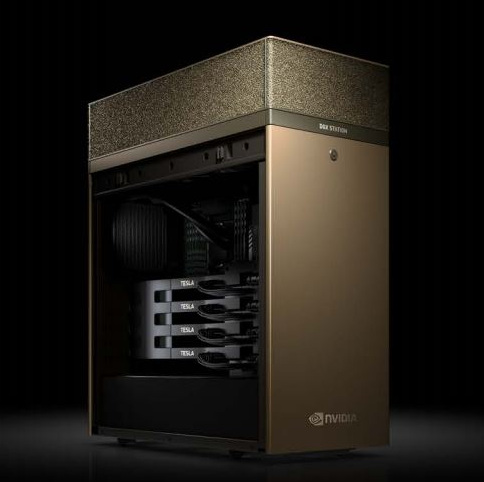Nvidia brings first Ray-Tracing capable video card to market.
Nvidia announced their Turing-based video cards, including the Professional Quadro RTX 8000, RTX 6000 and RTX 5000 GPUs at Siggraph and their consumer level cards the GeForce RTX 2070, RTX 2080 and RTX 2080 Ti GPUs at Gamescom in Germany (you can read about them here) with the promise of in real-time performance for ray tracing for visual effects software and in games. They neglected to share any benchmarks…
So let’s talk about the Professional cards and what they mean. Now before you go out and buy one, they aren’t available till October, and the three versions range in cost from about $6,000, to about $10,000. Still, there’s some cool things you can do with them.
Epic/Nvidia/ILMxLabs recently demo’d the Unreal Engine showcasing some ray-traced video. Of course Captain Phasma in her chrome armor makes an excellent reflective surface.
And while this is a cool tech demo, it was running on a $60,000 NVidia DGX Station (on sale for $49,000 for a limited time!). Here’s one.
 And it was rendered at 24 fps. And even then some of the scene was rasterized and not ray-traced – why do you think it took place in a elevator with matte walls? Maybe they could redo it on a brand new DGX-2? (with 16 Tesla V100 GPUs – that’s a $400,000 350LB behemoth – or just think of it as 5 Tesla Model X’s…)
And it was rendered at 24 fps. And even then some of the scene was rasterized and not ray-traced – why do you think it took place in a elevator with matte walls? Maybe they could redo it on a brand new DGX-2? (with 16 Tesla V100 GPUs – that’s a $400,000 350LB behemoth – or just think of it as 5 Tesla Model X’s…)
OK, so while it was bruteforcing the ray-tracing aspect, overall it was a nice demo. Though IMHO the best thing about it was the Imperial March elevator music 🙂
What’s this Ray Tracing thing?
Ray tracing is about how light bounces around (simple explanation video here.) Right now (and for the last 40 years) game engines have rasterized everything. Surfaces computed their own light reflections based upon where the camera was. So things like reflections, transparency, shadows, ambient occlusion, etc. needed to be fixed.
Ray tracing, simply put, lets the light ray bound around the scene, and some of them make it to the camera. It’s actually a very simple method that just happens to be incredibly computationally expensive. But you get realistic results, and things like shadows, transparency, reflection, refraction, etc. all just fall out. The Battlefield demo from the Nvidia twitch stream shows off some of the differences.
So does this matter? Not presently. Games (and most VFX tools) use OpenGL or DirectX – which is the rasterization interface from the game to the hardware. No ray tracing. The whole GFX pipeline will have to be rewritten. Exciting stuff, but it not going to happen overnight. Or next year. Or the year after that…
So what was the reason behind this announcement? When I was working in a VFX company we had written a custom high resolution video capture & playback plugin. The goal was to be able to use the Unreal engine to render an ultra-high quality video of the scene – as opposed to the usual Blender or Autodesk. Much faster to iterate.
So, what you see above is intended for VFX houses and not games. Epic (which demonstrably HAS rewritten their GFX pipeline for ray tracing, reportedly using Microsoft’s new DXR (DirectX Raytracing) framework, an API working through the current DirectX 12) and Nvidia realizes that this is a huge market for the them and they are chasing it with all their might. So this is great. But I’m not going to buy a $6000 video card for the few games that will have better visual effects in them. VFX houses, if you can promise they can ditch their render farms AND get faster turn around AND dump their very expensive site licenses for VFX tools with a free rendering engine – they will line up. Ray tracing support in Unreal will supposedly show up in version 4.22, so about Q1 2019.
Games and Virtual Reality
Nvidia also announced their consumer focused RTX cards – these are also ray-tracing capable but are also designed for gamers – and are more modestly priced from $500 to $1200. They are claiming a 6x improvement – again they gave no benchmark data, so we will see. They go on sale Sept. 20th. While the ray tracing is nice, I still will be playing OpenGL or DirectX based games for the next few years, and THAT is the performance numbers I want to see.
One of the more interesting things announced was the adoption of the VirtualLink standard that allows VR headsets to connect to the PC with just a single USB-C cable. This is a good thing and making HMD’s that plug directly into the video card (or the wireless connection) is a good thing for the XR industry.
So while this is an inevitable step in the evolution of graphics, I don’t see much of an effect upon the typical gamer in the next few years. XR folks might see some near-term benefit if most HMD manufacturers adopt VirtualLink. The real benefit will be to VFX houses as their cost of business is going to rapidly drop. So good news overall, this is the beginning of the adoption of ray tracing and a more physically-based graphics rendering – so things will look better. But not anytime soon.

